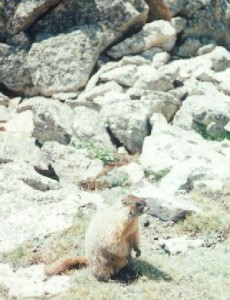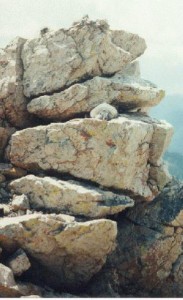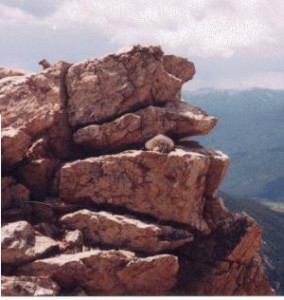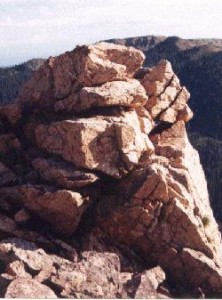As I sit at the computer, my furry paws racing across the keyboard, I have to consider the puzzlement of the reader as they contemplate reading a blog written by a marmot. Most people don’t even know what a marmot is! Explaining marmots is a topic for a different article, though. In this one, to get the ball rolling, I feel I should share how I came to be sitting at a desk.

Stormy is a yellow-bellied marmot.
I never really had great aspirations. I was perfectly happy living on one of the ridges of Mount Ida in the Rocky Mountain National Park. Being a marmot is a pretty easy job. You roll out of your burrow when it gets light out, gorge on the local vegetation, sun yourself and get back home before its gets dark. When winter comes and snow falls, you manage to squeeze your butt down into the burrow and take a winter-long nap. Marmots hibernate. That’s a part of the job. The butt gets big gorging in the summer and when you wake up in the spring, you’re half the marmot you used to be. Hibernation is the toughest part of the job.

Sheltered rocky outcroppings make for great homes for marmots!
Throughout the summer I witnessed hundreds of human tourists wandering up the trail, trying to reach Mount Ida, the peak of which is at 12,880 feet above the sea level. Sitting on my rock I got to see a lot of gasping tourists wandering by and it wasn’t the beauty of the majestic Rocky Mountains that most of them were gasping at. My home was 2.1 miles above sea level. Air up at this elevation is pretty thin (60-65% of sea level) and the exertion of hiking up a steep mountain catches up to inexperienced tourists pretty quickly. A lot of people who try to make the summit turn back long before they reach it. This is not an easy hike. Adding to the complexity of the hike is Colorado weather. This high up you can get snow in the summer and as a rule, on most afternoons, the skies will open up with a short down burst that will wash the hardiest of adventurers back down the mountain.
It’s best to try to make the summit in the morning, but vacationing tourists love to sleep in and there’s a price to pay for that. The other marmots and I would sit on the outcropping that is a part of our home and watch people shuffle by. We’d make bets on which ones would be coming back unsuccessful. Most of the time it was pretty easy to tell. Big fat tourists who think they can take on the wilderness are more often suitable snacks for the bears and the mountain lions. Most of these, though, turn back as soon as they clear the tree line and get a good look at what they will be in for. Past the initial steep ascent through the woods, the trail to Mount Ida closely follows the up and down terrain of the Continental Divide. It winds past my burrow and heads out into the parts of the wilderness that I never visited. Those places are too far, too high and too exposed to the eyes of the predators. The final leg of the journey to the top of Mount Ida is up a steep rocky slope. This is perhaps the toughest part of the journey and those who were not overcome by the steep ascent of the first leg and the endurance draining second leg, will often turn back when they realize that they must overcome a huge boulder field that reaches high into the sky. Of the hundreds who may attempt this hike each day, only dozens actually succeed in seeing the vast wilderness of the northern portion of the Rocky Mountain National Park from atop Mount Ida.

Marmots live high in the Rocky Mountains in rugged high altitude terrains.
Today was a slow day on the mountain. The morning was warm and sunny, but not a lot of people made their way up the mountain. It was around mid-day when I witnessed a group heading up the trail. They looked fairly fit and stood a good chance, so no one really bet against their ability to make it to the top, but off to the north there was cloud cover and based on prior weather experience, it was easy to tell that there was a storm coming. Tourists. They were going to get some excitement out of their hike! This group took a break next to my outcropping and had a snack. It didn’t take too long for a pack of us marmots to gather up around these people and work as hard as we could at looking cute. This is one of the lessons that our mothers teach us early on. People are suckers for cute and tend to carry a lot of food. When they see something that’s cute, they try to feed it. Now, it’s important to stress that park rangers say you’re not supposed to feed the wildlife. They claim it makes us less self-sufficient and we suffer by not maintaining our hunter-gatherer skills. My personal thought is that if I can get each tourist to hand me a cracker (that’s an average of 100 a day), I’ll be the world’s fattest marmot come hibernation time. That’s really all we’re doing, after all – getting ready for the winter.
This group tried not to feed us, but cute is really hard to resist. It was quickly evident that after they left, we’d have some crumbs to clean up, which is a good deal when you’re a lazy marmot. Nice tourists tend to be hard to come by. Most are too tired to care about the wildlife. Some yell at you for no apparent reason. Some even throw rocks. Young humans chase and try to catch you. These people just enjoyed having our company. Thankful as I was for the crumbs, I tried to warn them that bad weather was coming and the top of Mount Ida was not going to be a good place this afternoon, but my chirping went unanswered. Sure enough, soon after we were done gorging on the remaining crumbs, a cold wind came from the north and it was clear the weather was going to turn fast. Everyone scampered to their burrows. I hung out on the ledge for a bit, watching the churning clouds, then as the drops of water began to fall, I crawled into my burrow and relaxed.
The storm lasted less than an hour, but when I came out, the mountain had changed. There were wisps of fog blowing around and hail had fallen on the ground. Everything was wet and slick and cold. I lay on a rock sheltered by the outcropping, waiting for the sun to come back out and dry this wet mess up. The trail remained empty for over an hour. No one in their right mind would start up the mountain in this weather. And no one in their right mind should be there when this weather hits. Well, that’s not quite true. We all knew one group was up there and it was just about now that I saw them heading back. They were wet and cold and miserable and listening to them I gathered that they made it halfway up the final leg before the weather overtook them. Normally I would have written them off as just another bunch of tourists, but then something unexpected happened. They took a break in the same spot as before and they were still nice to me. That’s just unheard of. Most people coming down the mountain are downright grumpy, especially if they get caught in a storm like the one that just passed.
I must admit, I’m a curious marmot. Often I’d sit on my rock, looking down into the valley bellow. In the spaces between the trees, over 1000 feet down, I would see large metal boxes racing by on the back surface trails. Marmot lore held that people sat inside those boxes and that they went far faster than we could imagine from up here, that the black trails were specially built and that all of them led to large people colonies. This is the dangerous moment when an idea overtakes you and you do something that will forever change your life. And so starts the story of my adventure.
Editor’s note: Please follow all park rules in regards to animals. Often these rules may not make sense, but they are in place for a reason and they are designed to keep both people and animals safe. In the events depicted in this story no animals were allowed to gorge on granola, although the braver ones managed to make off with some sunflower seeds. No animal was removed from the Rocky Mountain National Park, one of the premiere jewels in the national parks system.
[whohit]2001-08-12 Marmot Beginnings[/whohit]















